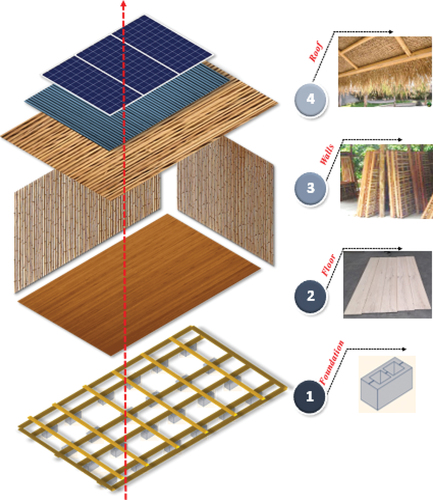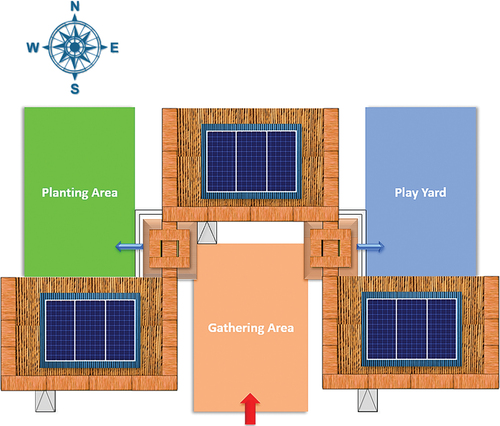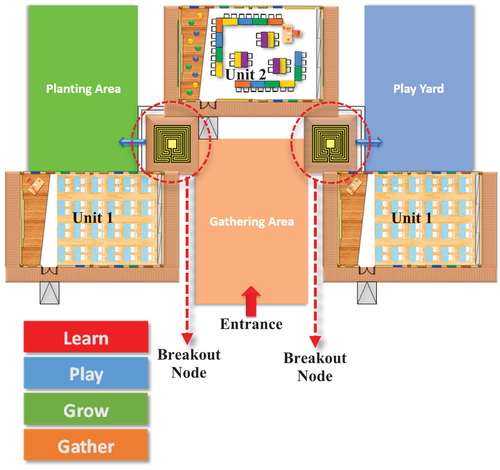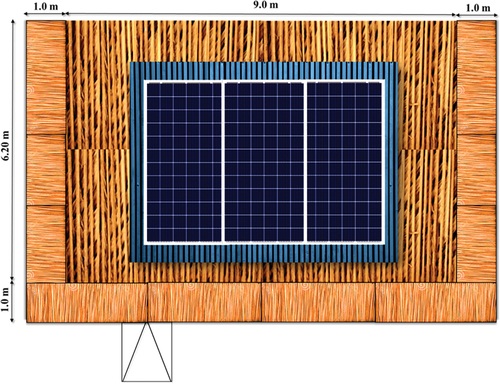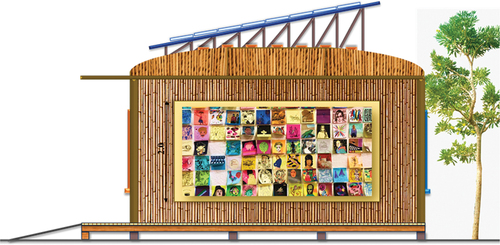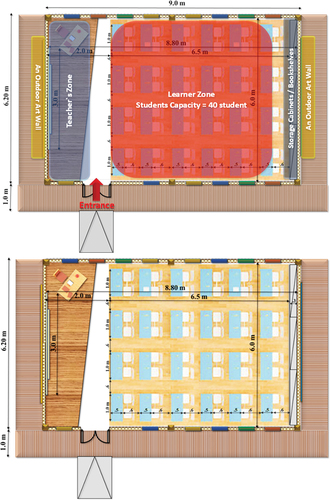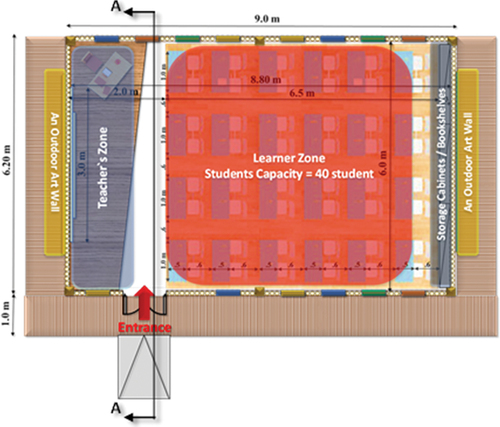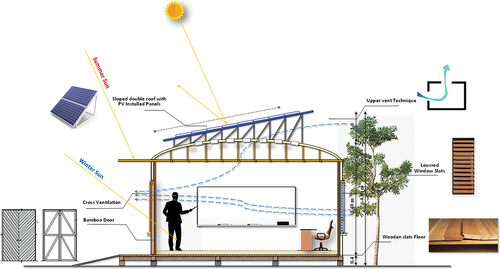ABSTRACT
Educational spaces are one of the most critical operations laid down with the architect, school design is a foundation to build/re-build any community. According to current financial variabilities, political crises, and continuous lack of resources, a gap between human classes is widespread, leading to extremely poor, and recently refugees’ communities. Regarding to education, the problem is that traditional school buildings with fixed structures are not effective nor available to these categories with extremely low resources and barley any infrastructure, therefore, it is essential to adopt new concepts to activate the function and impact of educational spaces in these urgent communities. The study aims to create a school “system” to fulfill the task of providing educational spaces, depending on the elements of adaptability with considering social, low-cost impact according to main definitions. With implementing the child`s psychological- physiological development elements, age category from 6 :13 years “Middle childhood: Early adolescence” inside the design process. In Egypt, there are several areas of extremely poor living conditions, the two highly alarming case studies are first, Upper Egypt`s rural villages having the highest ratio of extreme poverty in Egypt, second, refugee camps that became part and parcel of any standing country, both representing urgent need for children`s education rescue. This paper is concentrating as a beginning on first case study as it has the highest percentage of out- school children. As result, trying to fulfill the task by creating an applied school system (project-based) with the adopted criteria, suitable to selected areas main conditions..
Introduction
It has been crucial in the current era to adopt new concepts of designing adaptive school systems as an urgent solution to activate the function and impact of educational spaces in the most unfortunate communities and reduce classes gaps through education. In this paper, the process depends on proposing an applied base (project-based methodology) as an approach to adaptive, socio-economic school systems ready to be implemented in several ways.
Hence, first, an illustrated poverty map is needed as a base to state the country’s current situation before acting. Worldly, according to the world’s poverty clock 2023, more than six hundred million people are in extreme poverty, half of them are children [Citation1] [Citation2]. In Egypt, according to 2023 updated ratios, with the national poverty line standing at approximately EGP 800 per month, 32.5% of Egyptians are below the poverty line[Citation2], more than 5% of them are in extreme poverty, with more than 1.65 million children counted as extremely poor [Citation2] (the targeted category). After initially recovering from the COVID-19 pandemic, the Egyptian economy has been hit hard by the fallout from the war in Ukraine and other recent crises. In January 2023, inflation initially stood at 21% but sharply rose to 40.2%, reaching the highest rate recorded in many years[Citation3], and with the pound in free fall, Egypt has been shut out of international financial markets and forced to seek an IMF bailout, leading to cut in food and fuel subsidies, which raised poverty ratios in a very fast rhythm[Citation4]. More current pressure on household budgets is raised every day and is fueling a continuous increase in national poverty rates in Egypt.
Selected area of the study
Upper Egypt’s rural villages (poverty situation and main locations)
According to Egypt’s CAPMAS, the highest rates of poverty are centered in Upper Egypt’s rural districts which represent 25.2% of total population, 52% of them are in extreme poverty, unable to secure their basic needs, despite all the government efforts to improve the living conditions, the ratios are terribly steady [Citation3,Citation5].
Seven out of ten poorest governorates in Egypt are located in Upper Egypt, topped by Assiut recording the highest poverty rates of 66.7% among its population, then Suhag 59.6%, Luxor 55.3% and Minya 54.7%. The ratios also included Aswan 46.2% and Qena 41.3% [Citation3,Citation5]. In other regions, governorates of New Valley recorded fifth place by 52.6%, then Matrouh by 50.1%, Beheira ranked seventh by 47.7% and finally in the top 10 was North Sinai by 38.4%[Citation3,Citation5]. Port Said recorded the lowest poverty rate of 7.6% [Citation5] ().
Figure 1. Poverty and acute poverty according to regions. Upper Egypt rural has the highest ratio. CAPMAS latest update [Citation3].
![Figure 1. Poverty and acute poverty according to regions. Upper Egypt rural has the highest ratio. CAPMAS latest update [Citation3].](/cms/asset/85fe2b9f-238b-40c0-bbe5-6f5b1daa05ad/thbr_a_2303797_f0001_oc.jpg)
Although Assiut has the highest poverty ratio as governorate, Suhag has the highest number of the poorest rural villages in Egypt, with 236 villages falling below the poverty line. This accounts for 87% of its total population[Citation3] ().
Figure 2. Number and locations of the poorest rural villages in Egypt. [Citation3] CAPMAS latest update, analyzed by the authors.
![Figure 2. Number and locations of the poorest rural villages in Egypt. [Citation3] CAPMAS latest update, analyzed by the authors.](/cms/asset/76410a83-159b-4b76-ac81-469c6eb658e1/thbr_a_2303797_f0002_oc.jpg)
Upper Egypt’s learning and schools status (current situation basic data)
Table 1. Basic ratios of children’s learning and schools’ situation in upper Egypt till 2023.
Egypt’s SDG 2030 (regarding both poverty and education)
Table 2. Egypt’s SDG 2030 (regarding poverty and education), followed by analyzing the current status by the author.
The suggested methodology for selected areas
According to the selected category’s living conditions with many challenges (stated in ) it is essential to deal differently with the design of educational spaces, adopting new concepts of designing not common school buildings barely available or sufficient, but flexible ‘school systems’ ready to adapt with the nature of urgency and lack of resources of selected areas. The applied system will deal with SLC Units (Small learning communities) [Citation13] ready enough to fulfill the child’s basic educational needs till at least 12 years old.
The study depends on the following elements as main aspects of the design process (the suggested methodology) as in :
Main aspects of adaptability and socio-economic approach
The process can be summarized through the following
Table 3. Factors of socio-economic adaptability in building environment. Illustrated by the author.
Child's psychological–physiological approach
Simply, activating the child’s development elements () through the school main zones in the process of design and layout arrangement, targeting ages from 6 to 13 years old (middle childhood to late childhood [Citation17,Citation18]).
Figure 4. Child's psychological–physiological development elements and its relation to school zones [Citation17,Citation18]. Summarized and arranged by the author.
![Figure 4. Child's psychological–physiological development elements and its relation to school zones [Citation17,Citation18]. Summarized and arranged by the author.](/cms/asset/bcc565b1-396f-4fcc-b177-0055600a0f6e/thbr_a_2303797_f0004_oc.jpg)
The applied school system for Upper Egypt’s rural villages
Project's location/map
The location is poorest Upper Egypt’s rural villages , having similar living/environmental conditions to be able to apply the same suggested modeling with little changes.
Figure 5. A map of Upper Egypt [Citation19], locating the project's main targeted locations.
![Figure 5. A map of Upper Egypt [Citation19], locating the project's main targeted locations.](/cms/asset/9883939c-8649-4fc3-9457-27beac781132/thbr_a_2303797_f0005_oc.jpg)
Project's main design data
The project would be based as an SLC Unit (Small learning communities) [Citation13] based on the main educational space (classroom Unit), connected by both corridors and breakout areas, with in-between outdoor spaces functioning according to each location, (as in ). At first, the project`s basic design data can be implemented as in ,
Table 4. The project’s basic design data. By the author.

The project's design modeling
Given the currently lacking infrastructure, land, planning and basic construction resources, the main concept is to create an urgent system that is easy to construct and operate, depending on the absence of complex structures, flexibility and well use of surrounding available resources and techniques. ‘An Easy Assemble/Disassemble Structure’ is selected as an effective construction model to meet these requirements. With a simple structure, that can be easily gathered, transported, assembled and constructed in any chosen location with few logistic considerations. The project’s construction phases are arranged as follows: (shown in )
The assembled unit construction mechanism:
1. Foundation: 8″ × 8″ × 16″ precast hollow core concrete blocks (Cinder Blocks) are ideal for flat or on-grade foundation support, raising the unit’s structure off the ground to protect it from soil’s moisture, insects and all kinds of rots [Citation20]. The construction will start by distributing the blocks in each corner, then supporting the middle poles and then half-way in-between or about every 6 feet to 9 feet (2 to 3 m) around the perimeter to shape a foundation grid[Citation20].
First Foundation Base: The classroom unit dimensions = 6 × 9 m2, so according to distribution measurements, the unit would need around 20 concrete hollow blocks. Tools needed in the process are just measuring tools, a shovel and small garden trowel [Citation20].
Second Foundation Base: Establishing a grid of wooden beams to connect the concrete blocks foundation and support the weight of the platform. Making sure that the foundation is level and stable (the beams installation process would be achieved either with mortise and tenon technique or with simple joints and nails).
Floors: Once the foundation is in place, a wooden raised platform would be installed for the flooring, using treated wood to prevent rot and insect damage. The platform should be leveled and securely fastened to the foundation.
Walls: Pre-cast ready-tied bamboo frames will be set up (the four walls are made of bamboo poles tied together firmly with wire or nylon cord to create a frame). The openings (louvered wooden window slates and a bamboo door) will be installed on each wall either in fabrication phase or on-site with the needed proper tools.
Roofing: A double roof technique would be used in each unit to keep the classroom unit cool, stimulate airflow and protect from extremely hot summers in Upper Egypt.
First Roof: a vault made of connected Palm leaves would be installed in the first level from inside, with needed support structure either of bamboo poles, wooden panels, or palm core, formed in curved way to guarantee optimum thermal comfort.
Second Roof: sloped light-weight steel sheet will be hanging up as double roof, with installed PV (photovoltaic) panels to generate the needed electric power in each classroom unit.
Educational unit's design
Each SLC (Small Learning Community) contains three classroom studios (minimum) shown in , with an area of 80 m2/classroom (built space of 6 × 9 m2 + 1 m wooden porch in U shape around each classroom covered with light palm roof as shown in , and unit`s facades designed as in , each classroom has the capacity of 40 students, so the 3 classrooms combined unit can have up to 120 students (at first phase) and can be easily multiplied with the same criteria according to each village needed ratios. Two different classroom interior zones are introduced to provide a suitable space according to each age phase needs (Late childhood /middle childhood ). Two breakout areas connect the three classroom units as basic grouped activity circulation nodes. The combined unit also contains three essential outdoor zones with natural/recycled interior elements as in (play – grow – gather) to complete the child's development.
Figure 13. A shape of recycled units that can be designed in the outdoor play area for age 6 to 9 years old.
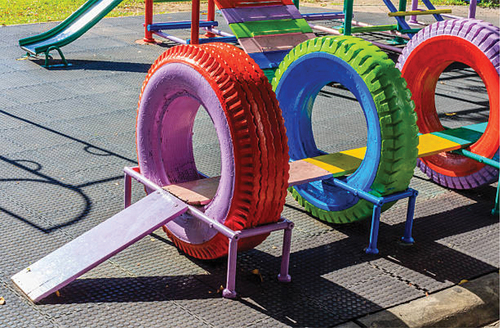
Each plan unit contains three main zones inside the classroom to activate the learning process: (as in )
1 – Learner/shared zone to activate educational and innovative activities inside classroom unit (Unit 1 (late childhood): a traditional cells and bells classroom type is more suitable to the needs of this age to activate his cognitive development elements) [Citation18], (Unit 2 (middle childhood): with this small age, more sociable shared studio type is needed to activate his senses using graphs, colorful pictures and 3d modelings) [Citation18]. 2 – Teacher’s zone which also can be used in (Unit 1 (late childhood): as class stage, and a collaborative area equipped with one or more computer devices powered through installed PV Panels in the roof of each unit) (Unit 2 (middle childhood): as colorful class stage, and shared activities display area). 3 – Storage cabinets/bookshelves area designed with light flexible materials (Unit 1 (late childhood): using light wooden organized closets is more suitable), (Unit 2 (middle childhood): using a light drawer boxes cabinets to be more flexible and approachable to deal with in this small age).
4 – An outside wooden porch surrounding each classroom (with 1 meter width and a ramp entrance) plays an essential role in the learning process, designed to represent an indoor–outdoor connection [Citation18], with art/science display walls for children’s activities. Shown in facade . 5 – Facilities needed: distributed portable toilet cabins would be installed in the parameter of each assembled unit according to each location (Note: Element 5 is not displayed in the project’s masterplan because it may differ according to each location’s parameters).
Assembled unit fabrication and transportation process:
Fabrication and Storage: the assembled unit consists of precast ready-available structure elements that could be just assembled in different selected villages. At first, these elements would be manufactured in its own environment, then would be stored in portable or fixed warehouse anywhere inside Upper Egypt’s governorates (20 concrete hollow blocks 8″ × 8″ × 16″ for foundations, wooden panels for floors, Tied ready 4 bamboo walls, bamboo door, 14 louvered window slats, Tied palm leaves vault roof (divided to several parts plus its structure panels), light steel sheet with installed PV panels as double roof, with its frame panels). Also, elements of furnishing, painting materials, tools and porch’s wooden panels will be brought and stored.
Transportation: When needed, the fabricated elements of educational units will be shipped and transported through a Moffett semi-truck as in (big, open and with multi-attached trailers as needed).
Suitable Soil and Local Laborers: when units are transported to the appointed village, a proper location with healthy uncontaminated soil should be selected, with area of 80 m2/Unit and 660 m2/combined unit of 3 classrooms, having the ability to multiply the number according to need + extra land for planting, gathering and playing yards (small school community). For the construction process, using local laborers as working hands is essential for adaptability.
Assembling the Unit: as previously illustrated in (Assembly/Disassembly Process Mechanism).
Construction elements that should be considered in assembled units
This kind of systems, although it has many qualities (easier to take products and assemblies apart so can easily be reused or recycled, reduce costs and environmental impact associated with adapting buildings to new uses [Citation15]), it needs a regular constant maintenance to ensure that each constructed element is in proper condition, and some components will shortly face replacement and re-arrangement to fit the process [Citation15].
1. As for bamboo poles used in the walls structure:
Bamboo poles are available in a lot of areas in the Nile River Valley in Upper Egypt where the climate is relatively more humid and suitable for its growing. The length of bamboo poles that are commonly available in Egypt may vary depending on the species of bamboo and the cultivation methods used, the commonly existed ones are from 4 to 6 meters tall, but, despite its availability, it is not widely spread in Egypt in building techniques, normally used more in furniture, cause most people are used to more fixed construction materials [Citation21].
So, when manufacturing the ready to use bamboo walls, we must consider the following:
The height of the bamboo walls will affect the length of the poles needed. To create longer walls, the bamboo poles can be joined together using various techniques, such as lashing, splicing, or metal connectors [Citation22].
The diameter of bamboo poles also affects the process; the used poles should be with appropriate diameter according to their selected height [Citation22].
For the walls, we can use bamboo poles or panels. If using poles, the construction used is to tie them firmly together with wires or nylon cords to create a stable frame. The bamboo panels can be attached to the frame using screws or nails [Citation22].
Ensure that the created bamboo wall is structurally sound and can withstand winds and other environmental factors [Citation22].
The stability of the walls may include using appropriate foundation materials, such as concrete blocks or stone blocks, to anchor the bamboo poles properly, with using braces or other supports to reinforce the walls [Citation23].
2. The Used Openings (Doors/Windows):
Classroom door: a bamboo-ready frame is to be used in each unit.
Classroom windows: Louvered wooden window slats are to be used with a volume appropriate to the area’s environmental condition.
A third element must be added to ensure adapting with the area, Mosquito Netting Layer is to be added to the openings. Mosquito netting is a mesh fabric that is used to create a barrier against mosquitoes and other insects [Citation24]. It is made from a variety of materials, cotton, polyester and nylon [Citation25]. It is an effective and affordable way to protect against flying insects that are commonly widespread in Upper Egypt’s villages[Citation26].
3. Furniture and Finishings:
The Classroom Furniture: each unit should be furnished with light, flexible, materials, such as wood, plastic or bamboo desks and chairs. The desks and chairs are not attached as normally used in Egyptian schools. They are de-attached to be easily moved and re-arranged for different teaching patterns according to the needs of each class.
Finishing: Finally, applying finishing touches to the classroom, such as painting and colors, stickering or varnishing the wood to protect it from different elements, all with sustainable, affordable and easy-to-construct ways. Children can easily participate in the finishing process to activate their sense of belonging to their classroom unit.
Assembled unit sustainability and eco-system integrated elements
The classroom unit is designed to conclude several eco-system and sustainable techniques implementing the following: Natural/available materials in the whole construction process with favorable thermal mass – Simple non-complicated structure techniques – Double roof technique: First Roof: palm leaves vault formed in curved way to guarantee optimum thermal comfort, Second Roof: sloped light-weight steel sheet with installed PV panels – Upper vent technique: through the vault’s upper openings air circulation – Cross ventilation with simple louvered window slats – Shaded walls from sun and rain by the overhanging roof guaranteeing passive heating/cooling system – High trees block harsh summer sun and allow warm winter sun. shown in vertical section A-A , (The section line taken for vertical section A-A is illustrated in ).
Conclusions
The aim of this study is to find new concepts to deal with the function and impact of educational spaces in impoverished most urgent communities, through creating flexible educational systems with an adaptive socio-economic approach, instead of resorting to steady buildings in communities with no clear infrastructure, land, planning or even the ability to reserve main necessities of life. To achieve this aim, this paper introduced a modeling to be applied in Egypt’s poorest areas (Upper Egypt’s rural villages) after collecting basic data of the area’s current educational status, poverty ratios, top affected governorates and targeting locations. The applied design approach depends on three main aspects to achieve its followed methodology:
The elements of adaptability, that can be concluded as follows: Flexibility (the ability to adapt with variable changes), Convertibility (the ability to create multi-functional spaces) – Expandability (shrinking and expanding elements) – Simplicity (the absence of complex systems) – Durability (Selecting materials, assemblies and systems that require less maintenance, repair and replacement) – Portability (the ability to assemble, disassemble, reuse its parts) – Independence (permitting removal or an upgrade without affecting the performance of connected systems) – Environmental Impact (developing an eco-system sustainable on-site unit) – Cost – Impact (a socio-economic base as part and parcel of adaptability).
The socio-economic base of the selected area, which depends on coping with little or no additional capital through onsite resources availability, local varieties and applying simple ‘common-sense’ principles to facilitate a wide range of possible changes that are expected to occur in the very near future.
Implementing the child’s psychological-physiological development elements in the system's educational spaces design process. the study is concerned with primary and the beginning of middle education as the minimum proper needed education to any child according to UNICEF, which are from 6 to 13 years old, represented as middle childhood from 6 to 9 years old [Citation18], late childhood from 9 to 13 years old [Citation18]. The main six perspectives of the child’s development elements are summarized as (physical – cognitive – thinking – language – personality – social).
The introduced modeling case-study tried to apply the suggested methodology to deal with educational spaces in the most urgent communities. Tested through the following assessment process ():
Table 5. Assessing the adaptive, socio-economic and physiological-psychological elements of the project. The result by the author.
Findings and recommendations
In general, school buildings in Egypt need more creative ideas to deal with both quantity and quality of educational spaces, away from traditional cells and bells design to more open muti-usage learning environments with different classroom’s patterns. As for the selected category of extremely poor communities, dealing with locations with certain construction challenges such as lack of land, poor planning, scarce infrastructure, and barely any available resources made it a necessity not a privilege to activate the function and impact of educational spaces through more flexible concepts as an urgent solution to an urgent need. This category can be dealt with by transitioning from common steady school buildings with fixed structure, which are neither effective nor available to this category, to the concept of creating school systems with flexible, simple and community-based structure, to ensure the completion of the minimum 12-year education requirement and to reduce the gaps through education.
The school system design approach should depend on specific criteria to be applied and assessed by at the end of the process. There are many forms and shapes of school systems to be implemented, such as semi-fixed structure units, floating systems, community-based structure, foldable/portable units, easy assembly/disassembly structure and mobile units. Each system can be applied according to the case, location and environmental changes. In this paper, the project depended on an easily assembled/disassembled structure gathered all from surrounding available resources with flexible construction elements and applied pattern of an SLC (small learning community) based design.
There are many aspects to be considered in educational spaces design, with the following main criteria: Adaptability, which can be concluded through its main factors (flexibility, convertibility, expandability, simplicity, durability, portability, independence, environmental impact and cost-impact). Considering socio-economic impact that depends on coping with the surrounding community through on-site resources, variabilities and traditions, dealing with little or no additional capital. Implementing children's psychological–physiological development elements (physical – cognitive – thinking – language – personality – social) in educational spaces design is important to activate the child’s built-on character through each school zone (private zone – shared zone – public zone).
Acknowledgments
We are grateful to CAPMAS Egypt, UNICEF Egypt and other official organizations for providing the available data and statistics. Also, a master’s degree thesis of the author from Architectural Engineering department, Mansoura University, Egypt, has a main base to this paper.
Disclosure statement
No potential conflict of interest was reported by the author(s).
Additional information
Funding
References
- World Data Lab. World Poverty Clock 2023. Federal Ministry of Economic Cooperation and Development , Gernamy & IFAD-UN. 2023. [cited 2023 June 17]. https://worldpoverty.io
- Genoni M. The World Bank (IBRD-IDA). Poverty lines 2023 - Poverty& Equity Brief - Arab Republic of Egypt. World Bank Group (Poverty& Equity). 2023. https://pip.worldbank.org/home.
- CAPMAS EGYPT (Central Agency for Public Mobilization and Statistics). 2023. https://www.capmas.gov.eg/.
- Arezki R. Egypt’s economic crisis is a golden opportunity. January 18, 2023. https://www.project-syndicate.org/commentary/egypt-economic-crisis-opportunity-for-structural-reforms-by-rabah-arezki-2023-01.
- Online A. Egypt’s poverty rate dropped to 29.7% in 2019/20: CAPMAS. October 17, 2022. https://english.ahram.org.eg/News/477989.aspx.
- Countrymeters. Egyptian country meters. 2023. https://Countrymeters.Info/En/Egypt#googlevignette
- UNICEF – GOVERNMENT OF EGYPT COUNTRY PROGRAMME 2023 - 2027. Protecting& Fulfilling The Rights Of Children In Egypt (pdf). https://www.unicef.org/egypt/media/10221/file/UNICEF%20%E2%80%93%20Government%20of%20Egypt%20Country%20Programme%202023%20-%202027.pdf.
- UNICEF EGYPT. Protecting and Fulfilling the Rights of Children in Egypt (Main Highlights). January 2023. https://www.Unicef.org/egypt/reports/protecting-And-Fulfilling-Rights-Children-Egypt
- Ewiss MAZ. The availability and quality of school buildings in Egypt. Article In International Journal Of Humanities And Social Science · May 2020. https://www.researchgate.net/publication/351477737.
- Zaalouk M. Community schools: filling the education void in rural upper Egypt. African Develop Bank. 2019. Available from: https://elnidaa.org/app/uploads/2019/05/PB5_basic_educ.pdf
- UNICEF Egypt. Education (Challenges& Solutions). 2020. https://Www.Unicef.org/Egypt/Education.
- Girgis H. “Localization of sustainable development goals in Egypt” part I establishing quantitative targets for the sustainable development goals at governorate level. A report for Egyptian Cen Public Opinion Res (Baseera). 2020 October.
- Nair P, Fielding R. The language of school design: design patterns for 21st Century schools”, a book published by: design share - the Harvard education publishing group – USA – December 15th, 2013.
- Shahbazi M, Bemanian MR, Saremi HR. Analysis of effective key factors in adaptability of a building in the future with emphasis on flexibility in historical buildings (case study: bu-ali of Hamadan). Space Ontol Intern J. 2017;6(1):69–78.
- Russell P, Moffatt S. “Adaptability of buildings”. IEA annex 31 energy-related environmental impact of buildings. IEA Annex 31. researchgate.net. 2001 November.
- John MK, Heidrich O, Vincenza ET. Change factors and the adaptability of buildings. Sustainability. August 2020;12(16):6585. doi: 10.3390/su12166585
- Bee H. Child`s Development Elements. The Developing Child. 9th ed. Vol. 1. UK: A Book Published By: Pearson Higher Education; 13th February 2011.
- Ghalwash OR. Psychology based Approach to Future School Design, Master Thesis, Mansura, Egypt: Faculty of Engineering – Department of Architecture - Mansura University; 2017.
- IFAD. Upper Egypt rural development project. https://www.ifad.org/en/web/operations/-/project/1100001376.
- Sokol, Eugene (DIY Expert). How to build a shed base with concrete blocks [complete guide]. Plasticine House. 2020. https://plasticinehouse.com/makeing-shed-base-concrete-blocks/.
- Enterprise, The State of The Nation. How are alternative construction materials being used in Egypt? 2022 Enterprise Ventures LLC. June 2021.https://enterprise.press/greeneconomys/alternative-construction-materials-used-egypt/
- Minke G. Building with Bamboo: design and technology of a sustainable architecture. Basel, Switzerland: A book Published by Birkhäuser: Third and revised edition. ISBN-10 p. 3035625700. Jan 2023.
- Traditional building techniques. Eco Arc. http://www.ecoarc.org/html/ideology/build_tech.html
- Oxford Languages. Oxford English Dictionary (draft ed.). 2009. Oxford, UK: Oxford University Press.
- World Health Organization: Annex VII: Procedure for Treating Mosquito Nets and curtains (PDF). Archived From The Original (PDF) on September 16, 2012.
- Egyptian Academic Journal of Biological Sciences. Department of Entomology, Faculty of Sciences Ain Shams University. 2015;8(1) https://eajbsa.journals.ekb.eg/article_12919_da03a5dbbd39969e4975831e73c70fc6.pdf
- Burns A, Siegel J. International perspective on teaching the four skills in ELT: listening, speaking, reading and writing. A book published. Germany: Springer Link; 2018.
- Dudek M. Children’s spaces. 4th Edition ed. UK: A book published by: Architectural Press; 2012 May.
- Dudek M. Schools and kindergartens: a design manual second and revised edition, Basel, Switzerland: A book Published by: Birkhauser: September 2014.


